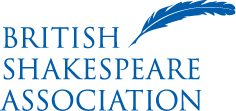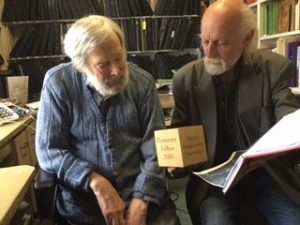Introducing Hamlet and Henry V through Penny Marchal’s Renaissnace Man
29th November 2017
By Yuto Koizumi
Yuto Koizumi is an Associate professor at Tokyo Institute of Technology. He teaches at the Institute of Liberal Arts, Tokyo Institute of Technology. His postgraduate research, on Shakespearean cinema, was undertaken at Waseda University. He also received an M.A. from King’s College, London. He has published several articles on Shakespeare and film.
This article is continued from Teaching Shakespeare, issue 13, on using film in the higher education Shakespeare classroom.
Renaissance Man and Henry V (and perhaps IV too)
 In his review of Renaissance Man, starring Danny DeVito, Roger Ebert offers a point for class discussion on the way in which teaching Shakespeare relates to the army, the film’s setting. He says his ‘doubts about the possibility of teaching Shakespeare in this way [with Rago’s enthusiasm] are surpassed only by my doubts about how the exercise has anything to do with the Army’. Before casting ‘doubt’ on this issue, I would ask my students how the film uses Shakespeare in the context of the film’s narrative/plot/screenplay and how Hamlet loses its central position. Interestingly, the film’s focus on Shakespeare shifts from teaching Hamlet to experiencing Henry V, a transition which Ebert somehow fails to catch. In the middle of the term, Rago takes his students to a theatre in Canada to show them a Shakespeare play; despite the expectation most audiences would have, the play is not Hamlet but Henry V. This is exactly the point I would like my students to notice and discuss further. Why does the film introduce this history play in the latter part of the story?
In his review of Renaissance Man, starring Danny DeVito, Roger Ebert offers a point for class discussion on the way in which teaching Shakespeare relates to the army, the film’s setting. He says his ‘doubts about the possibility of teaching Shakespeare in this way [with Rago’s enthusiasm] are surpassed only by my doubts about how the exercise has anything to do with the Army’. Before casting ‘doubt’ on this issue, I would ask my students how the film uses Shakespeare in the context of the film’s narrative/plot/screenplay and how Hamlet loses its central position. Interestingly, the film’s focus on Shakespeare shifts from teaching Hamlet to experiencing Henry V, a transition which Ebert somehow fails to catch. In the middle of the term, Rago takes his students to a theatre in Canada to show them a Shakespeare play; despite the expectation most audiences would have, the play is not Hamlet but Henry V. This is exactly the point I would like my students to notice and discuss further. Why does the film introduce this history play in the latter part of the story?
Renaissance Man deals with Henry V because it offers appropriate material to discuss war and soldiers. There are some visual points for my class to observe and ask: in terms of visual effect, why do Rago’s students wear army uniforms even when they go to the theatre? What happens next during night training? What kind of comments do they make about the play? Which speech from Henry V does a soldier recite during drill in the rain? All of these questions work to stimulate students who do not know what the history play is about yet.
Renaissance Man features perhaps the most famous speech in Henry V, the St. Crispin speech. In drill training under heavy rain, Sergeant Cass whiplashes his trainees; suddenly he orders Pvt. Melvin to recite any Shakespeare line, but Melvin cannot bring anything to mind. The drill in the rain is a good opportunity for Cass to challenge Rago’s class again and try to prove that learning literature does not make sense for military education. The Sergeant, then calls on Pvt. Benitez and orders him to do the same. Benitez starts to recite Henry’s St. Crispin speech and surprisingly remembers its entirety. The audience recall that Benitez bought and read Henry V’s text after Rago took him to the play: he saw the play, was inspired, and independently chose to study the play by himself.
This moment is one of the key scenes in which Shakespeare relates to the Army as Henry V is concerned with issues about the leader and his soldiers in a war. Sergeant Cass does not stop Benitez’s recitation just because the film wants to make the scene emotionally touching: rather, the sergeant realizes Benitez/Henry/Shakespeare is talking about how good soldiers should be in a state of emergency. Thus, the scene gives Shakespeare teachers like us an opportunity to ask students to read Henry V, particularly the speech, before or after the screening, and to consider the theme of war in the play.
The other scene in the film that refers to Shakespeare’s consideration of soldiers is Rago’s final exam. Picking up each character and plot, Rago asks his students for their interpretation of Hamlet. What is effective about Rago’s teaching method is that he then asks why the student has formed a certain impression of a certain character; Rago has also grown as a professional teacher who does not neglect his student’s own voice or his own idea, and does not rely on a textbook interpretation. Pvt. Haywood says he hates Laertes. Encouraged to go on, Haywood answers:
Laertes is a fool! He ain’t never stopped to think about what type of person Hamlet was. All he does is do what the king tells him to do. When he fights Hamlet, all they do is end up killin’ each other. That’s his problem. He don’t stop and think before he acts.
This idea gives an important perspective to military ethics: the soldier should be a loyal public servant, but he is simultaneously responsible for his individual decision to carry out his military service, for example using his weapons on the field of battle. Furthermore, Pvt. Melvin has also matured to compare his life of a soldier with Shakespeare’s idea. Asked ‘what do we get from this play?’ he concludes: ‘You know, all the people in the play, kings and queens and princes, they all die. And in the end, all that’s left is the two guys: Fortinbras and Horatio: soldier and student. Ain’t that somethin’ ?’
A teacher could use Melvin’s comment and asks his students why Shakespeare saves these two characters ultimately. In response, some students may think people need to have two mindsets in one personality: to keep thinking as an academic person and to never stop challenging as a courageous soldier, for instance. If the teacher could also describe how Henry was recognized as a prodigal son when he was Prince Hal in Henry IV, his students may be interested in the synchronicity between Rago’s students and the prodigal Prince: Renaissance Man is a film about low achievers coming to maturity through the power of liberal arts, just as Prince Hal grows up to be a noble king. Rago, then perhaps, may even be seen as a modern incarnation of Falstaff, but one who could not be dismissed by his ‘student’, instead inspiring the noble king.
Some students may discuss potential difficulties with the narrative structure of Renaissance Man if they pay attention to the film’s double focus on Hamlet and Henry V. It may be thought that introducing Henry V fails to make the film coherent rather than using only Hamlet, which greatly inspires Rago’s students first and foremost. However, what gives Renaissance Man a carefully thought out structure is the introduction of the history play with its considerations on the topic of war. As becomes obvious in the scene of the final exam, Rago’s students have learned to think by themselves; in this case, at least Haywood and Melvin look at Hamlet from a soldier’s point of view. This dual focus of the plot is necessary to show how the interpretation of one play enables students to learn from another play, even if these genres are far different; the narratives are somehow interconnected and thus may help one think of each play more deeply.
Conclusion
Renaissance Man is useful material to introduce and teach Shakespeare: in my class’s experience, it helps students enjoy Hamlet and (as we will see in issue 14) Henry V. Also, referencing and responding to Ebert’s review helped them analyze the film more insightfully. The most important point is that the film gives teachers an indication of a method to pass Shakespeare on to younger generations: connecting the Bard to our/students’ reality as closely as possible as Rago does. Renaissance Man, in this sense, is a comedy worth introducing to students, who potentially become inspired to look at the world through Shakespeare’s eyes.
Works Cited:
Ebert, Roger. ‘Renaissance Man’. RogerEbert.com. Jun. 3 (1994): n.p. Web. 25 Mar. 2017.
Robinson, Ken and Lou Aronica. Creative Schools. UK: Penguin Books, 2015.
Shakespeare, William. Hamlet. Ed. G. R. Hibbard. Oxford: Oxford University Press,











